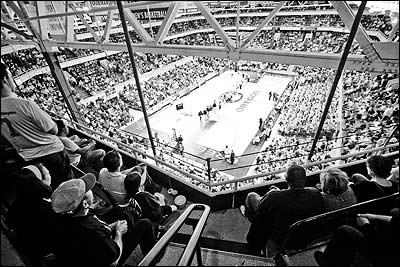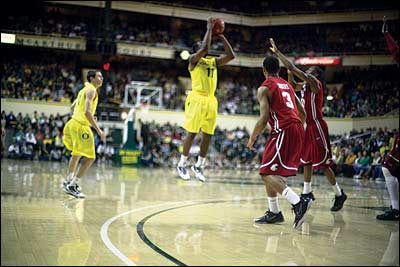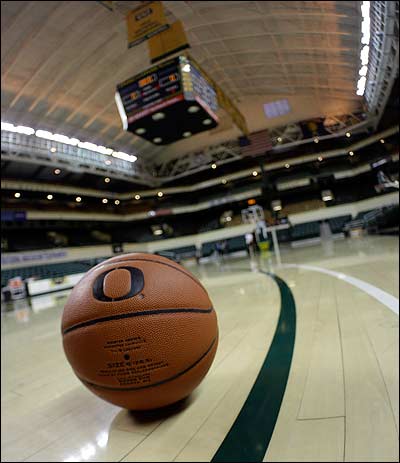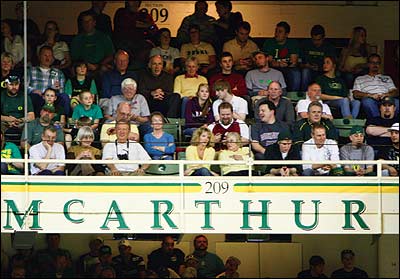Passion For The Pit
UO’s home floor is recalled by those who knew it best
by Rick Levin | photos by Trask Bedortha
 |
 |
 |
 |
 |
| long live the bingo queen, aka Victoria Williams. Photo by Todd Cooper |
 |
Ladies and gentlemen, Elvis has left the building — and soon, the building shall leave as well, at least in its present incarnation and function. And like the King’s departure, the death of UO’s McArthur Court will raise in its wake a ghostly waft of legend and nostalgia that will only grow more mythical with the passage of years, an aura of lost glory perhaps not as sequined and profanely holy as that of Elvis, but still very deep and heavy for the city and culture of Eugene. Yes, the pendulum of The Pit’s time is winding down, and if its future as a usable building remains unknown, its past is long and storied.
For instance, in 1976, just a year before he died on the toilet of a coronary infarction, Elvis played back-to-back shows in Mac Court, wearing his white jumpsuit and sporting his trademark lopsided snarl. And speaking of toilets, The Pit has always been the Pits for fans seated in the upper tiers who, beset by ballooning bladders or worse, have had to make the long and labyrinthine trek down to the ground level where the only bathrooms are located. All that pre-game beer, and such a long way to go.
Bob Dylan played Mac Court. So did Donovan, Chicago, Ray Charles and Three Dog Night. When President Barack Obama made a late-campaign appearance in March of 2008, that’s the Eugene venue he chose. A bomb even exploded there once, in October of 1963, but according to the Daily Emerald it was “barely noticed.”
As any fan of the men’s basketball team knows, the bombs that went off these past two years were mostly duds and certainly noticed. Just ask recently fired head coach Ernie Kent, whose 13-year tenure peaked with a 2007 appearance in the NCAA tournament’s “elite eight.” Since then, the Ducks have been mediocre at best, rudderless at worst. And yet, when the wallowing Ducks (8-23) beat Oregon State during the final home game of 2009, exuberant fans rushed the court as though the team had taken the trophy. There was something spectacularly bittersweet about that frenzy, like fireworks going off at a funeral. American buildings, and especially sports arenas, rarely get a second act. This might have been the unofficial swan song for Mac Court.
Similar to the pioneer graveyard located right across the street, McArthur Court is old enough to seem ancient in the minds of the modern sports fan. Its birth dates back to the era of flappers and Model Ts. In the mid 1920s, the Associated Students of the University of Oregon imposed upon its constituents a $15 fee per student, having decided “to tax ourselves to build what we want.” Part of what they wanted was, of course, an indoor sports arena. The pavilion, named after Clifton McArthur, a student athlete and the school’s first student body president, was erected in 1926 and hosted its first game on Jan. 14 of the next year — a 38-10 victory by the men’s team over Willamette (remember, regarding the lopsided score, that there were no shot clocks back then). In a delightful show of solidarity and defiance, the building’s mortgage papers were torched in a public ceremony in 1932, at the arguable nadir of the (first) Great Depression.
The kids just don’t do that sort of thing anymore.
From a structural point of view, Mac Court is an atavistic monster, more Roman coliseum than modern-day sports arena constructed with an eye to maximizing sight lines, comfort and convenience. The building is so vertically integrated and agoraphobic-unfriendly as to be vertiginous, with fans packed tight and high and practically sitting atop the players on the maple hardwood of the floor. According to UO professor emeritus of architecture Jerry Diethelm, The Pit’s layout, originally designed by Ellis Lawrence, gives the place a “ferocious interior intimacy” that is an expression of an antiquated era “when sports played a more supportive academic role and wasn’t so seriously monetized as to require a Matt Court,” a reference to the huge new Matthew Knight arena currently under construction along Franklin Boulevard.
“Lawrence’s modest pavilion,” Diethelm adds, “fit its campus role and place, and its innovative Modernist roof gave it an iconic structural hat signature on the campus skyline.”
The “ferocious interior intimacy” Diethelm applauds has been well documented as giving shit-fits to visiting teams who find themselves all but physically mobbed by the fans crowding the court. Take, for instance, one ritual still in practice to this day: During the pre-game introduction of visiting players, the entire student section stands and, turning their backs to the opposing team, shouts “Sucks!” after each name is called. In 2001, Sporting News named Mac Court the “best gym in American,” and it consistently has been voted, by players and coaches and sports publications alike, as one of the toughest places to play a road game.
Tim Wenzel, who has run the Pit’s timer for the past 28 years, said the home court advantage provided will be a difficult thing to replace. “Intimidation, that was the word that sprung right into my head,” Wenzel says about Mac Court’s distinct atmosphere. “The fans at floor level are right on top of the players which at times has taken opposing players right out of their game I’m really sorry to see it go. It would be difficult to duplicate.”
Perhaps no other era in UO hoops history exemplifies this notoriety than that of the Kamikaze Kids, a time of spastic gamesmanship that ranged the meatiest part of the 1970s, when Dick Harter was head coach and hard-nosed players like Ernie Kent, Ronnie Lee and Doug Little roved the floor with a tenacity that verged on the masochistic. It was perhaps during these years that The Pit achieved its Poe-like capacity to strike terror in the hearts of opposing players, who faced not only the immediate hell of diving Ducks but also a gaggle of fans who were so intense many were willing to sleep on the sidewalk outside the arena to land tickets.
Folks recalling these years speak in reverential tones of one fan in particular, a mysterious masked stranger who, to the galloping accompaniment of “The William Tell Overture,” would race around the arena dressed as the Lone Ranger, riding one of those old-fashioned toy ponies on a stick. According to Ken Hoiland, the origin of these collegiate antics date back to the start of the 1974-75 season, when the Ducks lost their home opener to No. 1 ranked UCLA by a mere four points. After a little post-game “liquid encouragement,” Hoiland says, his buddy suggested that for the next game he “get the crowd back into it” by dancing around to the Lone Ranger theme.
The idea worked. “The place went nuts,” Hoiland, who now lives in Portland, recalled. “There’s no doubt about it, we were way ahead of our time. It was ruthless how we treated opponents. Everybody was into it.” And, at the end of that season, Hoiland’s friends urged him to keep it up. “Next year it progressed to where it was a ritual,” which included firing off a cap gun and proceeding to “beat the crap” out of an effigy of the opposing team’s mascot. Frisbees would be flying around the arena, and the other team’s players were remorselessly taunted. “It was the biggest high of my life,” Hoiland says, admitting that he still gets goosebumps just talking about it. “It was just unbelievable. It was totally, totally nuts. If I did today what I did then, they wouldn’t let me into the place.”
Eugene resident Doug Little, who played basketball under Harter from 1968-1973, calls that era of aggressive play and the excitement it generated “something very special that will never happen again.” A versatile athlete who played every position from guard to center, Little characterizes the Kamikaze Kid style of play as “extremely aggressive,” noting that players were in continuous action, diving on loose balls and otherwise throwing their bodies around with little regard for self-preservation.
Little says that the heightened atmosphere created by frenzied fans had a direct and noticeable impact on games. “The level of noise was at an all-time high,” he recalls. “It energized you.” He figures that such fan-generated energy added, like some magical potion, as much as 10 points to his game and several inches to his vertical leap. “It’s something that gives me goosebumps even thinking about it,” Little adds, echoing Hoiland’s sentiment.
Yvonne O’Herron also remembers the jazzy thrill of watching the Kamikaze Kids in action. O’Herron is the only surviving founding member of the Daisy Ducks, a group of women sport fans organized by the UO Athletic Department in 1972; over the years, the volunteer efforts of the Daisy Ducks have included everything from running the half-time bingo draw to endowing scholarships to holding athletic department potlucks and making goodie bags for student-players heading off for away games. “I can remember the crowds when they would stomp their feet,” O’Herron says of being at home games. “At that time, the scoreboard would bounce up and down. At one time they had a live duck that they turned loose. It was a great time.”
It’s bittersweet to see Mac Court’s days come to an end, O’Herron says. “It’s sad, of course, but it had to happen,” she explains. “It’s served its purpose. I would like to see it remain and turned into something there.”
Once the last game is played there, whether by the volleyball team or the women’s or men’s basketball squad — and with the boy Ducks tentatively slated to open conference play next year at the new digs, it could be as soon as December — McArthur Court’s status will pass into utilitarian limbo. Questions about exactly what will become of The Pit remain unanswered at present. There are those, like UO graduate student Jonathan Bowers, who aggressively lobbied to retain Mac Court and who continue to take to task the logic of replacing it. Surely what’s done is done, but as the men in hardhats continue to cinch rivets on the Matthew Knight Arena, Bower admits to feeling “bitter” about those, like past UO President Dave Frohnmayer, who refuse to acknowledge the cultural, historic and fiscal injustice that’s been committed. Hell, Bowers says he’d have been willing to take the case to the Supreme Court if necessary (see Viewpoint, page 4).
Beyond any issues of future use or misuse, there’s already an aura of lost history that, for many fans and former players, makes the inevitable closing of Mac Court as a venue something bittersweet — even for a non-basketball fan like Victoria Williams. Williams, also known as “the Bingo Queen,” has been chairing the UO’s bingo program since 2000. Mac Court habitués recognize her as the elaborately costumed Duck fanatic who draws the winning balls at halftime. “I am doing all bingo, all the time,” Williams — who calls herself a Duck fan in general and a “rabid” football fan in particular — explains. “I’m happy to be able to make the contribution to the scholarships, and I’m happy not seeing the game.”
Despite her lack of enthusiasm for hoops, however, Williams says that Mac Court is a special place. When it’s rocking, she says, “it just crackles” with excitement. “You can always feel it,” she adds. “It’s definitely got its own character.” Williams especially loves the way fans can line up behind the ropes in order to share high-fives with the players coming and going from the locker room. “That is so cool,” she says.
The Bingo Queen understands that, when it comes to upgrading from McArthur Court, “we always have to move forward.” But this hardly means she doesn’t give a rip about The Pit. “I’m really concerned about what’s going to happen to Mac Court,” admits Williams, recalling that when she started as a UO student in 1979, she registered for classes at The Pit. What worries her most is the current direction being taken by UO athletics, which she feels are more and more dominated by corporate thinking. “I’m afraid to see it torn down,” she says of Mac Court, “but I’m afraid that’s what’s going to happen.”
Little recalls that, whenever he was out on the floor, there was “obviously a hell of a lot of tradition” surrounding the old arena. It had “that old Boston Garden-type feel,” Little says, with an ambiance that he called second to none. “You could feel the ghost of players past,” he adds, pointing out some of the big-name players who once called The Pit home, including “the two Lukes” (Ridnour and Jackson), as well as Greg Ballard and Ronnie Lee. “A bunch of phenomenal players have gone through there,” Little says.
“It would be great if they could keep using it in some capacity,” he says of Mac Court. At the very least, he’d like to see it put on the historical register and “definitely not tear it down.” Little says that, in a sense, the old arena contains a part of his “inner soul,” and that watching it close means “a part of you has kind of died, you know?”
The final game played there will be especially tough to watch. “There will be a tear in my eye,” says Little. “It won’t be easy.”
McArthur Court, aka ‘The Pit’
Address: 1801 University St.
Opened: December 1936
Chief designer: Ellis F. Lawrence, architect
Renovations: $5 million
Capacity: 9,087
Future: Uncertain